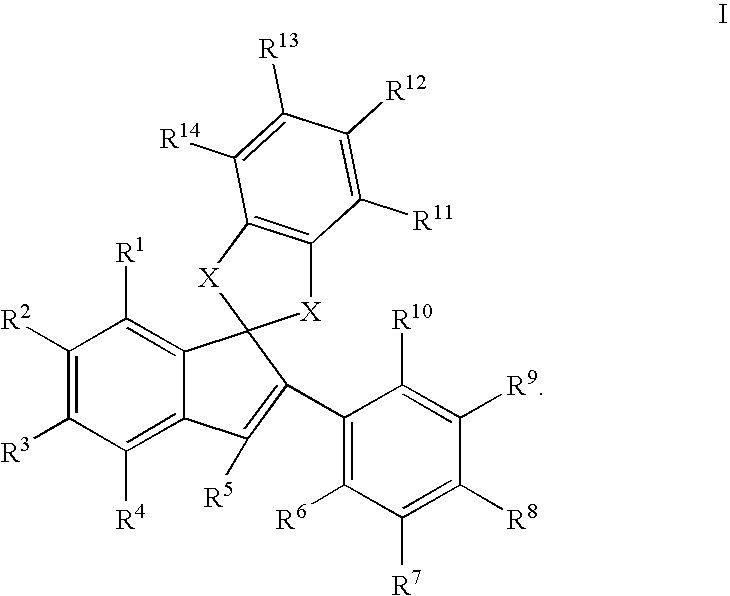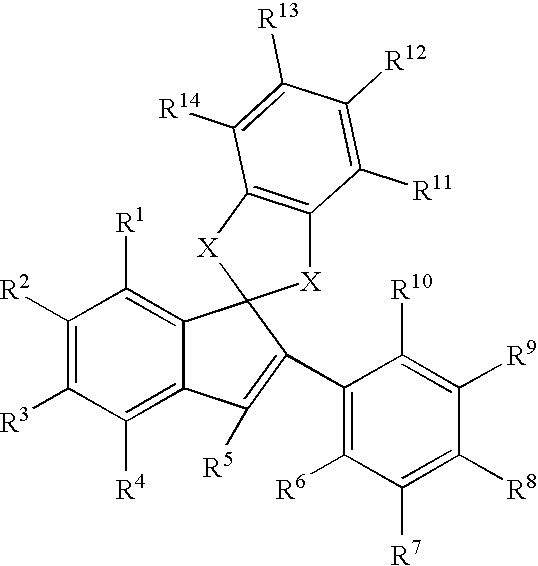Estrogen receptor modulators
a technology of estrogen receptors and receptors, applied in the field of estrogen receptor modulators, can solve the problems of limiting the use of this alternative, increasing fracture risk, and less than ideal treatment with tamoxifen
- Summary
- Abstract
- Description
- Claims
- Application Information
AI Technical Summary
Benefits of technology
Problems solved by technology
Method used
Image
Examples
example 1
2-Phenyl-5-hydroxy-1′,3′-dihydro-spiro[1H-indene-1,2′-[2H]indene]
Step 1: Potassium carbonate (0.86 g, 6.25 mmol) was added to a solution of anisindione (1.26 g, 5 mmol) in dry dimethylformamide (30 mL). The resulting dark red mixture was stirred at room temperature for 10 minutes then a solution of methyl-α-bromo-phenylacetate (1.50 g, 6.5 mmol) in dimethylformamide (10 mL) was added. The resulting mixture was stirred at 50° C. for 15 minutes (color changed from dark red to light orange) then partitioned between half-saturated aqueous ammonium chloride (250 mL) and ethyl acetate (200 mL). The aqueous layer was extracted with ethyl acetate (150 mL) and the combined organic layers were dried (MgSO4), filtered, and evaporated to an orange oil. The crude product was purified by recrystallization from hexane / ethyl acetate to afford the product as a white crystalline solid (mp 158-158.5° C.).Step 2: Glacial acetic acid (2 mL) was added to a solution of the product of step 1 (1.70 g, 4.25 ...
example 2
2-(4-Hydroxyphenyl)-5-hydroxy-1′,3′-dihydro-spiro[1H-indene-1,2′-[2H]indene]
Step 1: Potassium carbonate (1.38 g, 10 mmol) was added to a solution of anisindione (2.02 g, 8 mmol) in dry dimethylformamide (35 mL). The resulting dark red mixture was stirred at room temperature for 10 minutes then a solution of methyl-α-bromo-4-methoxy-phenylacetate (2.59 g, 10 mmol) in dimethylformamide (5 mL) was added. The resulting mixture was stirred at 50° C. for 15 minutes then partitioned between half-saturated aqueous ammonium chloride (400 mL) and ethyl acetate (250 mL). The aqueous layer was extracted with ethyl acetate (50 mL) and the combined organic layers were dried (MgSO4), filtered, and evaporated to an orange oil. The crude product was purified by flash chromatography on silica gel eluted with 3:1 hexane:ethyl acetate to afford the product as a light orange solid.Step 2: Glacial acetic acid (2 mL) was added to a solution of the product of step 1 (3.44 g, 8 mmol) in 100 mL of 1:1 ethyl ...
example 3
2-(3-Hydroxyphenyl)-5-hydroxy-1′,3′-dihydro-spiro[1H-indene-1,2′-[2H]indene]
Step 1: Potassium carbonate (0.617 g, 4.46 mmol) was added to a solution of anisindione (0.90 g, 3.57 mmol) in dry dimethylformamide (16 mL). The resulting dark red mixture was stirred at room temperature for 10 minutes then a solution of methyl-α-bromo-3-methoxy-phenylacetate (1.11 g, 4.28 mmol) in dimethylformamide (4 mL) was added. The resulting mixture was stirred at 50° C. for 20 minutes then partitioned between half-saturated aqueous ammonium chloride (200 mL) and ethyl acetate (100 mL). The aqueous layer was extracted with ethyl acetate (50 mL) and the combined organic layers were dried (MgSO4), filtered, and evaporated to an orange oil. The crude product was purified by flash chromatography on silica gel eluted with 3:1 hexane:ethyl acetate to afford the product as a light orange solid.Step 2: Glacial acetic acid (1 mL) was added to a solution of the product of step 1 (1.34 g, 3.11 mmol) in 50 mL of ...
PUM
| Property | Measurement | Unit |
|---|---|---|
| Pharmaceutically acceptable | aaaaa | aaaaa |
| Stereoisomer | aaaaa | aaaaa |
Abstract
Description
Claims
Application Information
 Login to View More
Login to View More - R&D
- Intellectual Property
- Life Sciences
- Materials
- Tech Scout
- Unparalleled Data Quality
- Higher Quality Content
- 60% Fewer Hallucinations
Browse by: Latest US Patents, China's latest patents, Technical Efficacy Thesaurus, Application Domain, Technology Topic, Popular Technical Reports.
© 2025 PatSnap. All rights reserved.Legal|Privacy policy|Modern Slavery Act Transparency Statement|Sitemap|About US| Contact US: help@patsnap.com



